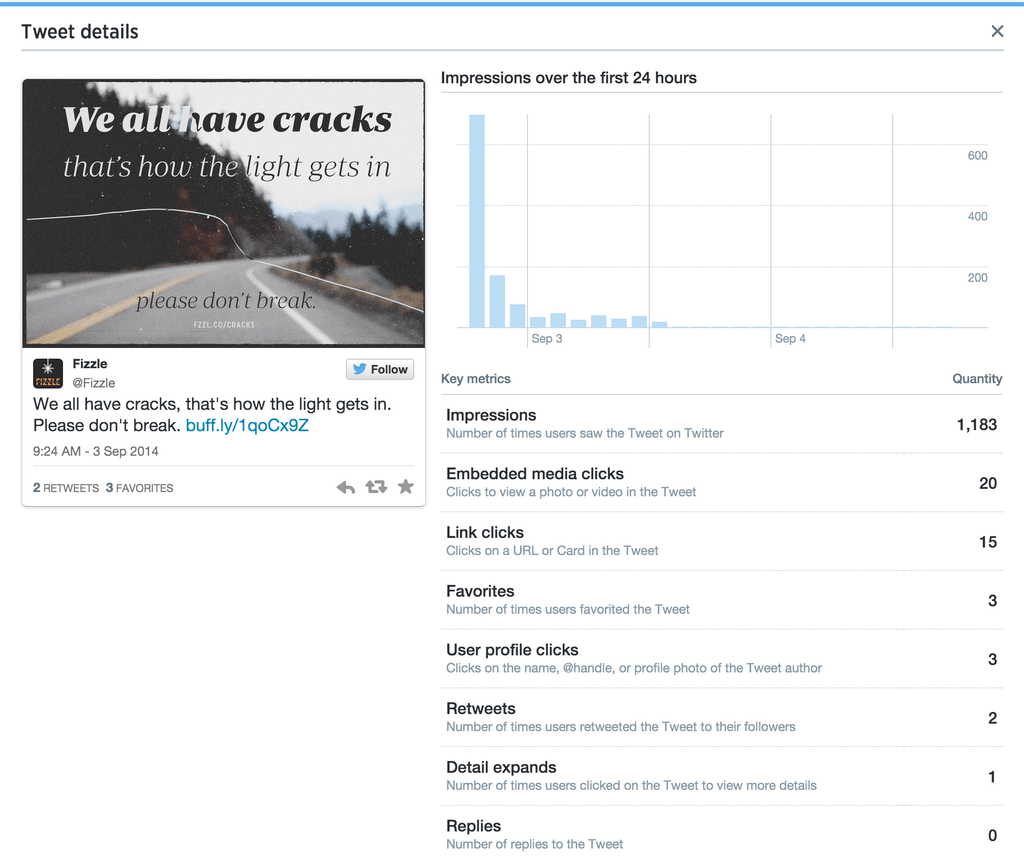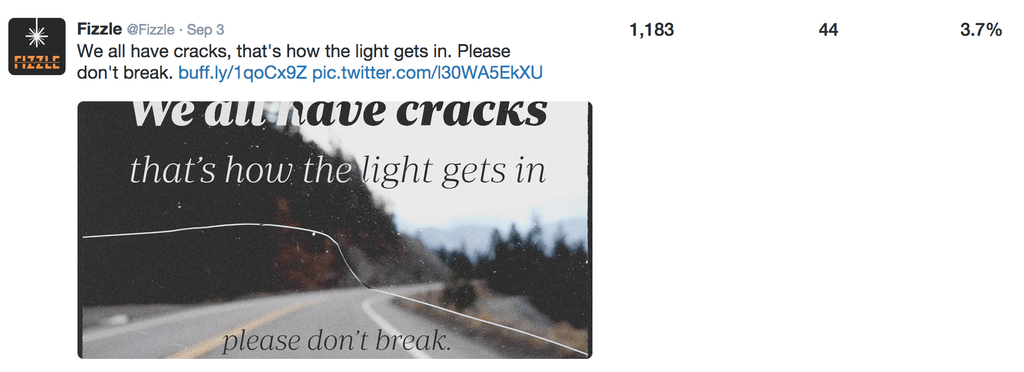How to Use Twitter’s Newly Opened Analytics to Find Great Blogging Ideas

Twitter announced (somewhat quietly) recently that Twitter Analytics are now open to everyone.
This simple tool makes Twitter much more valuable to people who create and publish things online. Here’s how.
If you’re logged in to Twitter, just visit analytics.twitter.com. You’ll see a bunch of interesting data on this page, including the following:

Then, below that graph, you’ll get a chronological listing of your tweets, including numbers for impressions, engagement and engagement rate:
If you click on an individual tweet, you’ll see the following expanded stats:

This detail hasn’t been available before, and it’s gold.
The big-picture account stats are interesting, but the real value is in the individual tweet stats. Now you can use Twitter to find great headline and content ideas, for blogging, videos, etc.
For example, we can see from the tweet above (posted from the @Fizzle account), that 42 people engaged with the tweet.
Twitter defines engagement as this:
“Total number of times a user has interacted with a Tweet. This includes all clicks anywhere on the Tweet (including hashtags, links, avatar, username, and Tweet expansion), retweets, replies, follows, and favorites.”
This goes beyond just favorites and retweets. When someone clicks a link or avatar or expands the tweet, that counts as well, along with replies and follows from a tweet. This is a great measure of how interested people are in any particular tweet.
Now, don’t worry about the absolute numbers, or about comparing your account to other accounts. I’m not even sure if Twitter’s analytics count activity through tools like Tweetbot as well, but it doesn’t matter.
What we care about is relative performance, between tweets of similar types, from the same account.
The value here is that we can quickly see how people react to different headlines, ideas, quotes, images, etc.
For example, check out the numbers on this next tweet (click on the image to see the original tweet):
This is from the same @fizzle account. Now we see that people weren’t really interested in the idea of “get on the list to get it in your inbox every tuesday.” That tells us something interesting.
We also know that the following tweet got a much higher response, with 122 total “engagements:”
These stats are all cues about what your followers (and their followers, from retweets) are most interested in.
You might already know some of this, from comments and shares on your own content, but the real value comes from being able to see engagement stats on ideas and thoughts and quotes, and when you share content from other sites. This is where your ideas will come from. More on that in a minute.
Here are a couple of other interesting observations from our data (this is data from our specific account, so your mileage may vary):
- Tweets with images have 93% more impressions on average than tweets without images (not counting reply tweets)
- Wednesday and Saturday had the lowest average impressions per tweet, with 12.6% and 11.1% fewer impressions than average, respectively. Sunday and Thursday had the highest, at 15.4% and 12.7% more impressions than average.
Note that you can export your stats as a CSV file, and pull them into a spreadsheet. The exported stats contain details like number of retweets, replies, favorites, profile clicks, url clicks and much more, on a per-tweet basis.
Now, here’s how to find ideas from your Twitter analytics data.
Writing entire blog posts to test ideas and see how people react takes hours. You can short-circuit this process by posting tweets on different ideas first. Then take the most engaged tweets and turn them into blog posts, videos, etc.
For example, this tweet received 10,377 impressions, which is far higher than average for this account:
"Don’t worry about the money. Love the process." – Joan Rivers
— Fizzle (@Fizzle) September 8, 2014
The concept + quote from that tweet could make a great blog post. Of course, Joan Rivers just passed away, so part of the interest might be from the timeliness of the tweet. This is an art, not a science.
Another place to look for ideas is from the engagement/impressions numbers on links you share from other sites.
For example, I noticed in tweets from my own @corbettbarr account that links to my friend James Clear’s blog were more engaging than my average tweet:
This tells me that my own followers are interested in the topics James writes about (and in his catchy headlines). Based on this, I should at least post more stuff from James, or perhaps I should write my own posts on similar topics.
Hopefully you’re getting the gist. By using Twitter’s analytics, you can short-circuit the process for finding great blogging/content ideas.
Post frequently, and try different thoughts, quotes and links to other sites. See how people react, and use those reactions to guide which content you create next. If you’re thinking about a specific idea, you could post several short soundbites to help figure out the right “hook” for your post, or even a specific headline.
Have you used Twitter’s analytics yet?
Head over to analytics.twitter.com now and see what you can learn from your own data. Post below if you have experiences or questions to share.
Earn a living doing something you love.
Grow an audience and get paid for your work as an independent creator. Fizzle is where creators come to learn, share and make progress toward their online dreams.
I’ve taken a lot of courses and been involved in several paid communities since I started my business, but I’ve never ever felt like anyone CARED as much about seeing my reach my goals as the Fizzle Team. They show up for me as much as I show up for myself. Thank you SO much, you guys!
 Claire Pelletreau
Claire Pelletreau
ClairePells.com
📓 Articles & Announcements
-
8 Experiments to Spice Up Your Podcasting Routine
Is your podcast routine stuck in a rut? If so, we’ve got just what you need! Jane Portman from Userlist joins us on the blog today to share her podcasting genius. Keep reading for 8 experiments you can try when your podcasting routine needs spicing
-
Introducing Fizzle 2.0
Today is an exciting day for Fizzle. We’re announcing a complete refresh of Fizzle, including every aspect of our user experience – courses, content, live events and more. Since we first opened Fizzle in 2012, we’ve provided thousands of entrepreneurs and creators with training, coaching and community. Today, this refresh marks
-
The Secret to Creating Consistent Content (that nobody’s talking about)
Hands up if you easily create consistent content week after week without fail. My guess? Since you’re reading this article, that’s probably not the case. Despite what you may be thinking – you’re not alone. Lots of content
🎙️ Podcast Episodes
-
The EXITpreneur’s Playbook with Joe Valley
Joe Valley is an Author, Guest Speaker, EXITpreneur, Advisor, and Partner at Quiet Light. He has also built, bought, or sold over half a dozen of his own companies. Over the last nine years, Joe has mentored thousands of entrepreneurs whose goal is to achieve their own eventual exit. He
-
R&D Tax Credits with Tiffany Bisconer
Tiffany Bisconer is a CPA with over 20 years of accounting and tax experience. Tiffany worked with one of the top certified public accounting firms before becoming director of Acena Consulting. She combines her private industry and public accounting experience to work with CPA firms and directly with business owners
-
Behind the Scenes: Fizzle 2.0
This has been an exciting month for Fizzle! We recently announced a complete refresh of Fizzle, including every aspect of our user experience – courses, content, live events and more. Since we first opened Fizzle in 2012, we’ve provided thousands of entrepreneurs and creators with training, coaching and community.









